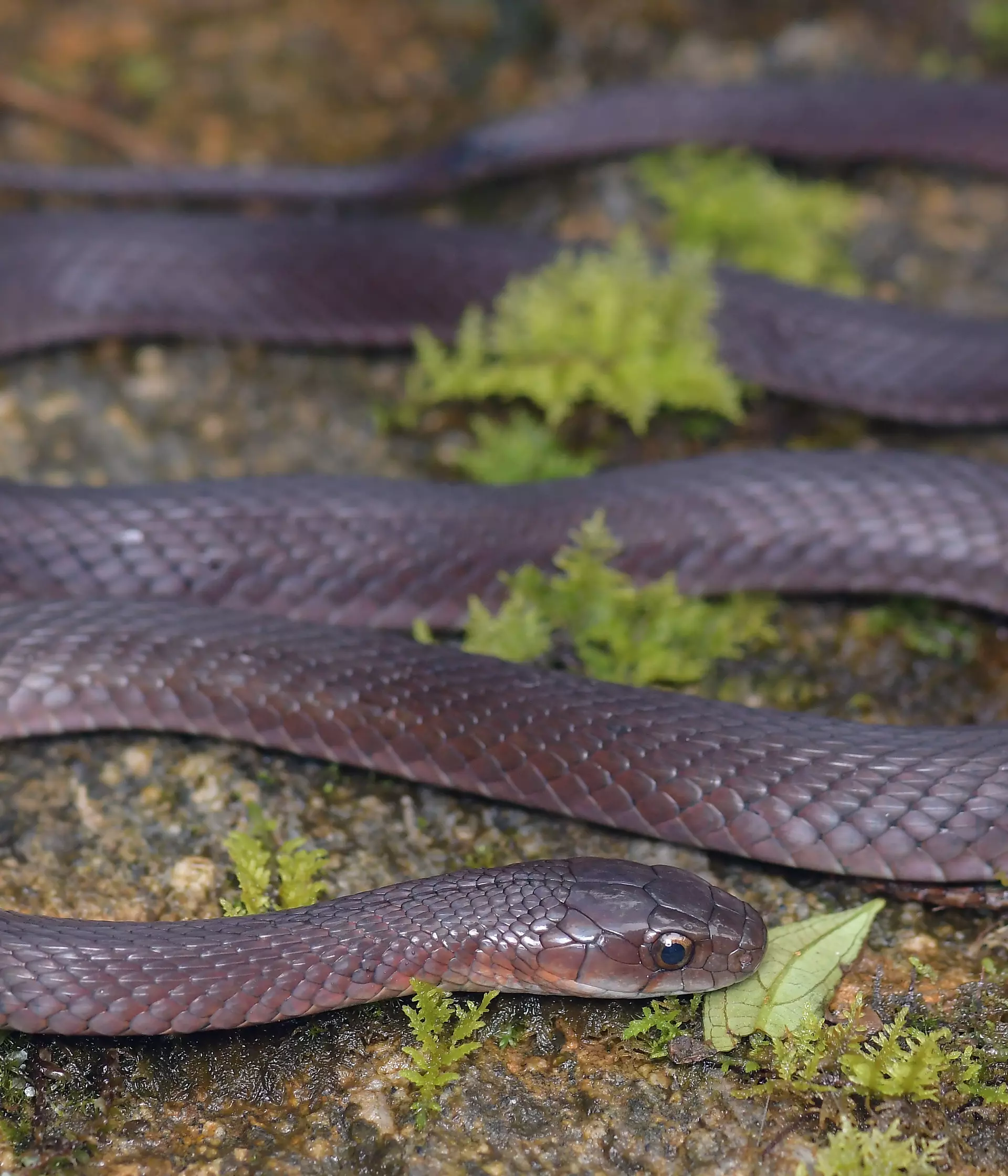ZSL’s Lead Herpetology Keeper, Daniel Kane, and EDGE Hero, Luan Thanh Nguyen, explain how searching for amphibians living in the mountains of northern Vietnam led to the unexpected discovery of an unusual snake.
Hoang Lien Range, northwest Vietnam. Several days into the 6 day expedition, we made our way through humid, lush forests up to our field camp at 2800 m above sea level. We were in these cloud-cloaked mountains collecting data on threatened frog species on Mount Fansipan – the country’s tallest mountain - and investigating the prevalence of disease-causing amphibian chytrid fungi, as part of our wider work protecting some of the world’s most unique and irreplicable species through our EDGE of Existence Programme.
Returning to camp shortly after midday after collecting supplies, two porters from the local H’mong community – Chang A Sung and Pao A Vang – came across a small, metallic purple snake. With an orange neck and a pale line along its upper jaw, the initial careful examination confirmed that this individual didn’t match the description for any currently described species of snake. This grabbed our attention, but too early for us to get excited about the discovery just yet.
How to identify a new species
The excitement came later. After returning to Hanoi and sharing news of this finding with the rest of the international team, Luan emailed photographs and measurements of the snake to our London-based team so that a more detailed comparison with other similar snake species could be undertaken. This revealed that this ‘new’ snake likely belonged to a fascinating group of snakes called keelbacks – generally medium-sized, semi-aquatic, snakes found across South, East, and South East Asia. Many, if not all, keelback snakes produce venom and intriguingly some are also poisonous, storing toxins from toads and firefly larvae in glands in their necks. Although generally harmless to humans, this unique feature helps them both defend themselves and hunt their prey.
This was not the only thing that the analysis revealed. The number of scales in key areas of this snake - along with its body colour and the place where it was found - did not match well with any description or photographs of other keelback species that we were able to find. It was starting to look like we could have something special.
We couldn’t celebrate just yet. There can be a lot of variation in the appearance of different individuals with the same species. We may be most familiar with this with species like humans and dogs, but the same is just as true for snakes - so looks alone are not always enough to confirm that a particular individual represents a species previously unknown to science.
Through DNA analysis we were able to generate a ‘tree’ showing this snakes’ position relative to that of its closest relatives. This confirmed that the snake does belong to the keelbacks (genus Rhabdophis), and it did indeed sit adjacent to all other described species. The DNA that we analysed is as much as 4% different from its next closest relative - that’s about as different as we are from gorillas.
Finally, after using the morphology of the snake in conjunction with its genetics – both of which showed clear differences from other species – we could confidently state this ‘new’ snake had indeed not yet been described by science.
This put us in an exciting position – we now had to name this species. It didn’t take us long to reach an agreement. This snake shares the Hoang Lien Mountains with the H’mong people, and throughout the years we’ve worked in the region, the contribution of porters from the local H’mong community – such as Chang A Sung and Pao A Vang - has been invaluable to the success of these expeditions. This species – the 34th keelback snake known to science - is therefore named the H’mong keelback snake (Rhabdophis hmongorum) in their honour.
Conservation in Vietnam
We have been working with partners in the Hoang Lien Range since 2015, leading to many important discoveries, many of which have been published in peer-reviewed research articles. The new snake represents the first reptile species described by our team, and the first new species of reptile discovered from the range in over a decade.
It’s an exciting discovery – and having a clear delineation of species is paramount for helping determine conservation priorities, but there’s still much for us to learn about the H’mong keelback snake.
During our search through genetic databases, we found a single record of a snake specimen from China which was a near-identical match to the H’mong keelback. However, the scientists who submitted the sequence from the Chinese specimen had not named it nor provided any further data. This shows that the species seems to be living across both sides of the border - but until further fieldwork happens, we have no additional data on the species’ distribution or on any variation within the species. It is only through additional research that we can build up a stronger idea of where the species is found, what threats it faces and what conservation measures are needed to protect it.
From our previous work conserving and describing amphibians in these mountains - and the relative lack of study to date on reptiles - it seems likely that there are more species waiting to be described and assessed for conservation requirements. This provides a great incentive for us to keep returning to these mountains so we can continue efforts to better understand the reptiles and amphibians living in northwest Vietnam, and what we can do to protect them.
Partner organisations:
- Asian Turtle Program of Indo-Myanmar Conservation
- Hoang Lien National Park
- Australian Museum
Funders:
This work was generously supported by The IUCN SSC Asian Species Action Partnership (ASAP) and a ZSL EDGE Hero award, and partly supported by the Asian Turtle Program of Indo-Myanmar Conservation.
